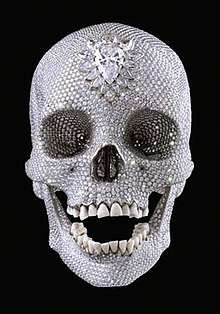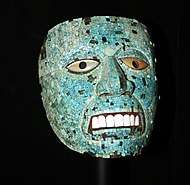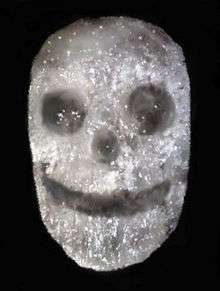For the Love of God
For the Love of God is a sculpture by artist Damien Hirst produced in 2007. It consists of a platinum cast of an 18th-century human skull encrusted with 8,601 flawless diamonds, including a pear-shaped pink diamond located in the forehead that is known as the Skull Star Diamond.[1] The skull's teeth are original, and were purchased by Hirst in London. The artwork is a memento mori, or reminder of the mortality of the viewer.
| For the Love of God | |
|---|---|
 | |
| Artist | Damien Hirst |
| Year | 2007 |
| Type | platinum, diamond, human teeth |
| Location | White Cube Gallery, London, England |
In 2007, art historian Rudi Fuchs, described the work as "out of this world, celestial almost. It proclaims victory over decay. At the same time it represents death as something infinitely more relentless. Compared to the tearful sadness of a vanitas scene, the diamond skull is glory itself."[2] Costing £14 million to produce, the work was placed on its inaugural display at the White Cube gallery in London in an exhibition Beyond Belief, with an asking price of £50 million. This would have been the highest price ever paid for a single work by a living artist.[3]
Production


The base for the work is a human skull bought in a shop in Islington. It is thought to be that of a 35-year-old European who lived between 1720 and 1810.[3] The work's title was supposedly inspired by Hirst's mother, who once asked, "For the love of God, what are you going to do next?"[4]
Designed and sculpted by Jack du Rose[5][6] and manufactured by the Piccadilly jewellers Bentley & Skinner, 8,601 flawless pavé-laid diamonds, weighing in total 1,106.18 carats (221.236 g),[7] over a platinum cast, cover the entirety of the skull. At the centre of the forehead lies a pear-shaped pink diamond, the centrepiece of the work. All diamonds used for the work are said to be ethically sourced.[3]
Hirst stated the idea for the work came from an Aztec turquoise skull at the British Museum.[3] However, artist John LeKay, a friend of Hirst's in the early 1990s, said the work is based on a skull covered with crystals which LeKay had made in 1993. LeKay said, "When I heard he was doing it, I felt like I was being punched in the gut. When I saw the image online, I felt that a part of me was in the piece. I was a bit shocked."[8]
Exhibition
On 1 June 2007, For the Love of God went on display in an illuminated glass case in a darkened room on the top floor of the White Cube gallery in St James's, London[3][7] with heavy security.[9] It was reported on 11 June 2007 that the singer George Michael and his partner Kenny Goss were interested in purchasing the piece for around £50 million.[10]
During November–December 2008, Hirst exhibited the diamond skull at the historic Rijksmuseum in Amsterdam, the Netherlands, amidst public controversy. The skull was exhibited next to an exhibition of paintings from the collection of the museum that were selected and curated by Hirst. According to Wim Pijbes, the museum director, there wasn't controversy amongst the board members. He explained that the exhibition "will attract people—and give a new aspect to the image of the Rijksmuseum as well. It boosts our image. Of course, we do the Old Masters but we are not a 'yesterday institution'. It's for now. And Damien Hirst shows this in a very strong way." A Belgian journalist in response remarked how the installation of the diamond skull at the Rijks was "an intentionally quite controversial project".
For the Love of God was also displayed in the Palazzo Vecchio in Florence, Italy, and at Tate Modern, London between 4 April 2012 and 25 June 2012.
The work was displayed at Hirst's first solo exhibition in the Middle East, at the Relics Exhibition of Doha, Qatar from 10 October 2013 to 22 January 2014.[11]
Between 16 September and 15 November 2015 the skull was displayed at Astrup Fearnley Museum of Modern Art in Oslo, Norway. [12]
Sale

Hirst said that the work was sold on 30 August 2007, for £50 million, to an anonymous consortium.[13] Christina Ruiz, editor of The Art Newspaper, claims that Hirst had failed to find a buyer and had been trying to offload the skull for £38 million.[14] Immediately after these allegations were made, Hirst claimed he had sold it for the full asking price, in cash, leaving no paper trail. The consortium that bought the piece included Hirst himself.[15]
In the 6 February 2012 issue of Time Magazine, Hirst elaborated, in his "10 Questions" interview: "In the end I covered my fabrication and a few other costs by selling a third of it to an investment group, who are anonymous."
Harry Levy, vice chairman of the London Diamond Bourse and Club, said "I would estimate the true worth of the skull as somewhere between £7 million and £10 million."[14] Her Majesty's Revenue and Customs would expect £8.5 million in VAT payments, if Hirst really did receive £50 million.[14] David Lee, editor of The Jackdaw, commented "Everyone in the art world knows Hirst hasn't sold the skull. It's clearly just an elaborate ruse to drum up publicity and rewrite the book value of all his other work."[14]
Media reporting and reviews
The media coverage of the "sale" of the diamond skull was extensive and led some to question to what extent the announcement of the sale was some kind of media art, especially as the "sale" continues to be in question.[16] This was further supported by the performative nature of the Sotheby's exhibition and auction of Hirst's artwork the following year.
In an article in The Guardian, Germaine Greer said, "Damien Hirst is a brand, because the art form of the 21st century is marketing. To develop so strong a brand on so conspicuously threadbare a rationale is hugely creative - revolutionary even."[17]
Richard Dorment, art critic of The Daily Telegraph, wrote: "If anyone but Hirst had made this curious object, we would be struck by its vulgarity. It looks like the kind of thing Asprey or Harrods might sell to credulous visitors from the oil states with unlimited amounts of money to spend, little taste, and no knowledge of art. I can imagine it gracing the drawing room of some African dictator or Colombian drug baron. But not just anyone made it - Hirst did. Knowing this, we look at it in a different way and realise that in the most brutal, direct way possible, For the Love of God questions something about the morality of art and money."[7]
Ralph Rugoff of the Hayward Gallery in London criticised the work as a mere decorative object, saying "It's not challenging or fresh. It's a decorative object which is not particularly well done."[18]
Robert Preece, an art critic of Sculpture magazine, wrote of the Sotheby's sales of Hirst's work: "I am not concerned with the details of these sales. What matters to me is that they were announced—unleashed, picked up, printed, reprinted, accelerated, translated, and multiplied across global media."[19] The performative nature of Hirst's work was later addressed in the exhibition at Tate Modern, "Pop Life: Art in a material world," which critic Ben Lewis found very offensive: "... the gallery texts have the temerity to claim that the greed-fuelled auction sale was a work of performance art in itself. That’s just the same as Stockhausen calling 9/11 a work of art."[20]
Artistic responses
In June and July 2007 Polish artist Peter Fuss presented his work "For the laugh of God" at the exhibitions in Gdańsk and London parodying Damien Hirst's For the love of God. The work was a plastic human skull covered in "artificial diamonds".[21]
A photo of the work thrown out with rubbish bags outside the White Cube gallery was a spoof by artist Laura Keeble[22] who created a replica skull with 6522 Swarovski crystals.[23]
In 2008, the Gaelic-language publisher Ùr-sgeul published a short story by Maoilios Caimbeul, "An Claigeann aig Damien Hirst" ("Damian Hirst's Skull"), as a fictional response to the work of art. This in turn was followed in 2009, by a single performed by the Gaelic rock band, Na Gathan, Claigeann Damien Hirst (Damian Hirst's Skull), released by Ùr-sgeul, which was inspired by Caimbeul's work.[24] The song was shortlisted in the Nòs-ùr contest for a new song in a Celtic language or Scots.[25]
In December 2008 Hirst threatened to sue the artist Cartrain for copyright infringement. Cartrain had incorporated photos of For the Love of God into collages and sold them on the Internet.[26][27]
In 2009, Spanish artist Eugenio Merino unveiled a piece entitled "4 The Love of Go(l)d", a giant sculpture, encased in glass, of Hirst shooting himself in the head. Merino, in fact an admirer of Hirst, intended the piece as a comment on the emphasis on money within the art world, and with Hirst in particular. "I thought that, given that he thinks so much about money, his next work could be that he shot himself," said Merino. "Like that the value of his work would increase dramatically...Obviously, though, he would not be around to enjoy it."[28]
In popular culture
The piece appears in the second episode of the American-Japanese animated television series Neo Yokio, when it is possessed by a demon at the Metropolitan Museum of Art.[29]
A skull that looks similar to For the Love of God serves as the driving force in the video game 50 Cent: Blood on the Sand.
For the Love of God graces the cover art of canadian rapper Tory Lanez's single "Diamonds," which he released on SoundCloud in 2017. [30]
References
- "Gold, Golden, Gilded, Glittering". Believer Magazine. 1 November 2012. Retrieved 9 June 2019.
- Sterling, Bruce (17 January 2011). "For the Love of God, it's Damien Hirst". Wired.
- "Hirst unveils £50m diamond skull". BBC News Online. BBC News. 1 June 2007. Retrieved 1 October 2014.
- Shaw, William (3 June 2007). "The Iceman Cometh". NYT. Retrieved 1 October 2014.
- Jack du Rose Archived 2 April 2015 at the Wayback Machine, official website
- Jones, Alice (18 November 2011). "The Diary: Jack du Rose; Nicholas Lloyd Webber; David Hockney; Russell Kane". The Independent. London.
- Dorment, Richard (1 June 2007). "For the love of art and money". The Telegraph. Telegraph Media Group. Retrieved 1 October 2014.
- Alberge, Dalya (27 June 2007). "My old friend Damien stole my skull idea". The Times. Times Newspapers. Retrieved 1 October 2014.
- BBC news report, retrieved 1 June 2007.
- Yahoo! Music (UK), retrieved 11 June 2007
- Relics Exhibition: Diamond Skull Artwork "Archived copy". Archived from the original on 3 November 2013. Retrieved 1 November 2013.CS1 maint: archived copy as title (link)
- http://afmuseet.no/en/utstillinger/2015/damien-hirst
- Byrne, Ciar (31 August 2007). "Hirst's glittering price tag loses none of its shine". London: The Independent. Retrieved 21 October 2008.
- Owen, Glen and Dunbar, Polly. Daily Mail, 9 September 2007.
- Evening Standard The avant gardener 19 May 2009
- Preece, Robert (January–February 2008). "Why I love Damien's skull". Sculpture. Retrieved 1 January 2010.
- Greer, Germaine (22 September 2008). "Germaine Greer Note to Robert Hughes: Bob, dear, Damien Hirst is just one of many artists you don't get". London: The Guardian. Retrieved 1 January 2010.
- Hirst's £50m skull? It's no more than a 'decorative object' (The Independent, March 8, 2008)
- Robert, Preece (March 2008). "Rock star on tour: Damien Hirst's skull at the Rijksmuseum". Sculpture. Retrieved 1 January 2010.
- Lewis, Ben (1 October 2009). "Pop Life sells its soul for the big bucks". London Evening Standard. Archived from the original on 5 October 2009. Retrieved 1 January 2010.
- Peter Fuss, For the laugh of God
- Laura Keeble "Forgotten Something?"
- Rawlings, Ashley. "Damien Hirst’s £50m artwork trashed: London’s White Cube Gallery gets bored with Hirst’s diamond skull, chucks it out", with photo of the spoof, tokyoartbeat.com, 18 July 2007.
- Nòs-ùr competition website, retrieved 16-4-09.
- Full points not Nil point for Sunrise Not Secular. Stornoway Gazette (16-4-09)
- Preece, Robert. (June 2009). 'Reality check: When appropriation becomes copyright infringement'. Sculpture magazine/AD&P. Retrieved 19 June 2009.
- Hirst demands share of artist's £65 copies
- Tremlett, Giles (18 February 2009). "'Suicide' sculpture of Damien Hirst causes controversy in Spain". London: The Guardian. Retrieved 18 February 2009.
- Sarabia, Luke (11 October 2017). "'Neo Yokios deadpan elegance may prove inaccessible to Netflix viewers | The McGill Tribune". The McGill Tribune. Retrieved 25 June 2018.
- DIAMONDS (PROD. C-SICK) // I TOLD YOU : AUGUST 19., retrieved 10 April 2020
External links
- frieze review of For the Love of God
- Pictures of the work's manufacture
- Interview with video
- Parody of For the Love of God by artists from Poland: Dead Drop Collector Glass, for drink, with skull inside by Cute Cube Collective, For the Laugh of God by Peter Fuss
- 1106.18 carats in grams
- Art theoretical text featuring Hirst's For the love of God: Bergande, W.: "The Liquidation of Art in Contemporary Art", in: Nordic Journal of Aesthetics No. 47 (2014)